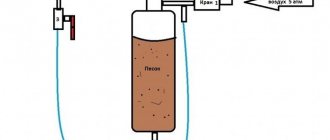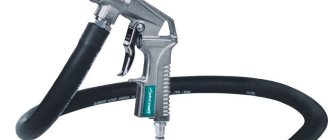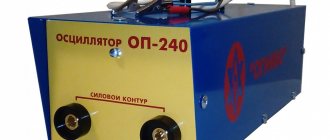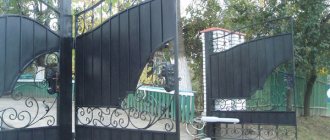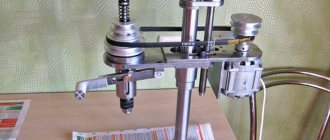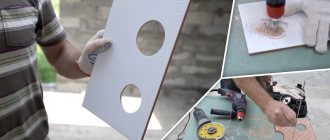Sandblasting allows you to quickly and efficiently clean surfaces from dirt and frost glass. The first type of operation is in great demand in small auto repair shops and even private garages. The problem is that the equipment sets on the market are expensive. At the same time, let’s say a home craftsman has a fairly powerful compressor. In this case, you can assemble a sandblasting machine with your own hands, using, literally, discarded items and parts that can be bought at any hardware store.
Pros and cons of homemade sandblasting
Pros:
- you will save money, since a home-made unit will cost much less than a purchased one;
- get a device more powerful than the factory one.
A homemade machine will help you cope with many household chores
Minuses:
- manufacturing the device requires, at a minimum, the ability to use a welding machine;
- if it was not possible to select high-quality components, sandblasting will not last long;
- any mistake in assembly can result in valve rupture and injury.
Think before you get down to business and correctly calculate your capabilities.
What is sandblasting?
How to clean metal from rust, scale, layers of old grease, carbon deposits? What if it’s not metal, but wood or concrete? Special chemical cleaners cannot be used everywhere and not always, and you have to rub the surface with sandpaper, metal brushes, and then admire the network of small and not very scratches.
An alternative to this treatment is sandblasting. With its help, you can remove various contaminants from the surface without any problems, and the treated area is cleaned much faster and more efficiently, and dirt is removed even from porous materials (for example, wood or concrete).
Another option for using sandblasting machines is working on wood or glass. With certain skills, you can make magnificent stained glass windows with selective matting, engravings and relief patterns.
A sandblasting machine is a fairly simple device in principle. It gives a powerful stream of air mixed with abrasive (ordinary sand). It can be used to process large areas as well as complex parts with many small elements. The flow of sand perfectly removes any layers of dirt, oxides and carbon deposits, leaving a clean surface without scratches.
Operating principle and purpose of the sandblasting machine
A sandblasting gun or other type of abrasive device purchased at a low price most often does not last long. The main parts of a cheap design quickly deteriorate and wear out, causing the device to become unusable. In order to save on the purchase of a high-quality device, you can use a homemade pistol, which works on the same principle as a magazine pistol.
The abrasive material (most often ordinary fine sand), under the influence of air from the flow created by the compressor, moves through a reinforced hose to the installation opening. It is fed through a nozzle directly onto the surface to be treated. Due to the high pressure, the sand moves, its particles act with high energy and clean off any contaminants. The installation itself is connected to a compressor on one side, and to a separate sand bunker on the other using special hoses.
In addition to cleaning surfaces from dirt, a sandblasting gun performs a number of other tasks:
- removal of old coatings;
- eliminating traces of corrosion;
- glass frosting;
- degreasing surfaces.
When using the machine, it is important to pay attention to the quality of the sand. It should be fine, clean, sifted through a sieve with the smallest mesh. When using contaminated coarse sand, the device nozzle becomes clogged and the gun breaks.
Recommendations for safe use of the nozzle
When using a homemade nozzle on a Karcher machine for sandblasting, you should adhere to safety requirements when working with such equipment. When using a Karcher washing machine, only water is supplied from its nozzle, which is not capable of harming the health of the operator. When using a sandblasting nozzle, in addition to high-pressure water, sand is also supplied from the tip of such a device, which can seriously injure the person operating such equipment. That is why when using such an attachment it is important to strictly adhere to the following safety rules:
- Processing should only be carried out in special closed-type clothing;
- shoes used for treatment using such a device must also be closed;
- All sandblasting work is best done outdoors.
Protective equipment when working with a sandblasting machine
Considering the fact that when using a Karcher apparatus and a homemade sandblasting nozzle, processing is carried out using a mixture of sand and water, it is not at all necessary to use face and respiratory protection in such cases.
When starting to make a sandblasting nozzle with your own hands, you should keep in mind that it will work effectively only if the compressor of your Karcher mini washer is capable of producing a stream of water under a sufficiently high pressure.
A sandblaster is an indispensable item in the garage. It is convenient to remove old paint, rust and other types of dirt. With the help of sandblasting, you can quickly and efficiently clean the most inaccessible places. This device can also be used to engrave on glass and other materials.
The author used a small compressor as the basis for the homemade product. Perhaps this is the most expensive part of the homemade product, which will cost about 3,500 rubles. As for sand, the device works perfectly on the most common construction sand, which must be sifted through a fine sieve before refueling. If you don’t want to tinker with sand, you can buy ready-made sand, especially for these purposes.
Of course, all work is carried out either in a special room or outdoors. You also need to take care of protective equipment. It is necessary to protect the breathing system from dust, and you will also need safety glasses or a mask to prevent sand from getting into your eyes. When working, there should be no exposed areas of skin, as loose grains of sand can dig into the code or leave a wound.
In the photo you can see what the homemade product looks like. As you can see, an ordinary bottle was used as a refilling container. And the homemade product looks like a spray gun.
Design features of the sandblasting unit
In order for the technical system to function correctly, it provides the following devices:
- sand nozzle with ceramic or steel tip;
- handle with trigger for controlling the device;
- fittings for connecting hoses necessary for supplying compressed air and sand;
- hoses for incoming abrasive and forced air;
- intake pipe or suction valve;
- a sand container with an outlet (for example, a small metal barrel or bottle).
The ideal option is to use homemade sandblasting not in the open air, but in a special chamber, which will increase work efficiency and reduce abrasive consumption. The chamber can be a box made of metal sheets, which is welded independently. Most factory camera models include the following items:
- glass viewing window for monitoring the material processing process;
- lighting system;
- two holes for gloves, in which the master places his hands;
- a grate at the bottom of the chamber and a chute for pouring waste sand;
- ventilation system to remove dust.
It is better to purchase the nozzle ready-made rather than making it yourself, this way it will last longer. It is almost impossible to make a nozzle of decent quality by hand. You will also have to buy a compressor, or take an old device that is available.
Accessories
In addition to the compressor and nozzle, before making a sandblaster, you need to prepare other necessary materials and tools. Most of them are available in every home workshop, but some will have to be purchased at a hardware or hardware store.
A used gas cylinder made of high-strength metal is suitable as a container for abrasive. The tightness of the cylinder also allows it to be used for storing and supplying sand. To make it more convenient to pour sand, you can weld a small piece of pipe to the top of the cylinder, which will serve as a “neck”. Instead of a cylinder, you can use any barrels or containers.
If buying a ready-made compressor causes financial difficulties, you can build it yourself. The basis will be a compressor head from a MAZ or ZIL pneumatic drive, the power of which is sufficient to create a good sandblast. The head must be equipped with a receiver, although you can work without it - then air will be taken in constantly.
Depending on the complexity of the finished structure, other components may be required:
- Ball Valves;
- rubber hose with reinforced inserts with a diameter of 14 mm or more;
- air hose with a diameter of up to 10 mm;
- fittings for attaching hoses or collet clamps;
- transition coupling;
- FUM tape for sealing and connecting elements;
- empty 0.5 liter plastic bottle;
- glue gun and hot glue;
- grinding machine or file, sandpaper with a block;
- drill with drills;
- sharp knife;
- Bulgarian;
- pliers.
Manufacturing diagram of a car compressor
A car pump with a wheel, which will act as a receiver, can also be used as a compressor. You will need the pump itself, a wheel, and a tee for the air hoses. It is necessary to put hoses on the tee and secure them with clamps. The first hose is connected to the wheel, the second to the compressor, and the third to the air gun.
A plastic bottle or a liter motor oil canister is used as a container for the abrasive.
After connecting all the elements, the tool is ready. Almost any automobile compressor is capable of creating a pressure of 6 atmospheres, which is quite enough for an abrasive jet. Even if the pump is weak, thanks to the wheel the installation will be operational.
Types of sandblasting machines by scope and principle of operation
Sandblasting can be divided into types according to several principles.
By scope:
- Vacuum. During operation, sand ejected through the nozzles is returned to the container using a vacuum and reused. Used for neat and delicate work.
- Pneumatic. Powerful devices that eject sand under strong pressure are used to process large areas.
- Suction. The air in such a device supplies sand to the nozzle and collects it back after use. Such devices are designed for removing paint and matting glass surfaces.
According to the sand supply principle:
- Pressure. The compressor pumps air into the dosing unit and into the installation itself. Thus, the maximum speed of abrasive particles is achieved.
- Injection. The abrasive and air flow move through different sleeves. The speed of sand particles in this case is low, and the apparatus itself is less powerful.
Principle of operation
Initially, we need to talk about devices for sandblasting. They consist of a compressor that pumps up air pressure, a container for mixing the abrasive with the air flow, and connecting hoses. The operating principle of the sand blaster is simple:
- The master starts the compressor. Waits for the pressure to rise to a certain level and opens the valve.
- The air flow mixes with abrasive particles.
- The master opens the valve on the supply hose, through which the working mixture comes out at great speed.
The operating principle of devices with a sandblasting gun differs from models that are not equipped with one. Main differences:
- An additional element allows you to precisely control the supply of air and abrasive.
- Makes it possible to process material locally or carry out large-scale cleaning.
The unit is convenient for decorative polishing of metal surfaces. You can give it a rough structure and matte it.
What tools and materials are needed to make a sandblasting machine with your own hands?
Returning to the issue of making sandblasting with your own hands, let’s consider what is required for the work:
- A compressor that provides pressure for the sandblaster. As we have already said, it is very difficult to make a compressor for sandblasting with your own hands, and the resulting result is unlikely to please you with its power. So you just need to buy this part. You will need a device with a power of at least 3 kW with a forced cooling system and a pair of piston groups.
- Container for abrasive. The main requirement for the tank is the correct slope of the walls, ensuring natural pouring of sand. The walls should be at an angle of 30 to 60°. The container must be made of thick-walled metal. A gas cylinder or fire extinguisher is excellent for this purpose.
Sandblasting can be done not only in open space, but also in a chamber. This option is suitable for processing small parts.
- The sleeve is easy to choose. For this, a rubber hose of the required diameter is sufficient. The hose is secured with metal clamps or ties.
- Nozzle – you can buy a ready-made nozzle or make it yourself from scrap material. To make the device last longer, it is equipped with replaceable ceramic caps with 5-6 mm holes for accurate operation.
To make a homemade sandblaster you will also need nozzles, taps and tees.
5 Engraving glass using a sandblasting device
First of all, you will need to cover the entire base of the glass with self-adhesive film. After this, you will need to draw the desired image and cut it out. The base of the resulting pattern must be carefully processed using a sandblasting device. After this stage of work is completed, the film will need to be removed. The drawing should be clear and bright. The master will be able to independently adjust the depth of the engraving by applying sand to the base several times. The image will look original both on its own and with LED backlighting. A homemade device can cope with the assigned tasks perfectly, and it will not be inferior to expensive products that are sold in specialized stores.
Using a sandblasting machine, it will be possible to cut holes on glass bases. To do this, you need to take a metal plate several millimeters thick and cut a recess in it. Next, you need to attach the sheet to the base and process it. This procedure will take 0.5 bottles of sand and a maximum of 5 minutes of time. The hole will be smooth and without chips. The sandblasting design shows excellent results in a variety of applications.
Making a sandblasting device yourself is quite simple. The main thing is to prepare all the necessary details and follow the sequence of actions.
How to make a portable sandblaster yourself - step by step diagram
This device may not boast large dimensions, but it can do the same job as its larger counterpart. True, its scale is a little smaller. To make a lightweight model you need to find:
- reinforced hose;
- ceramic nozzle (modified spark plug);
- compressor;
- plastic bottle (1.5 or 2 l);
- spray gun valve;
- plumbing tee;
- ball valve
In addition to a set of wrenches, in this case you will need a drilling and lathe machine to turn the faucet. Based on the diagram, a nozzle is assembled from a mixer, tee, ball valve, bottle and nozzle.
- The gun body is turned on a lathe to fit the size of the nozzle.
- It is connected to a tee mixer, one fitting is connected to the compressor, and a nozzle is mounted on the second. The third is connected to a container containing abrasive.
- They make a channel between the gun and the compressor. The tap is mounted between the bottle and the tee. The latter is connected to the handle of the spray gun.
- The top of the bottle is cut off.
This portable device is not durable, but it can effectively clean surfaces for about half an hour.
Types of sandblasters
There are two types of sandblasters: siphon and pressure sandblasters. Both types of sandblasters use compressed air from a compressor to operate, the difference lies in the way the abrasive is fed into the nozzle before being blown out under pressure. A siphon sandblaster uses an open, leak-proof hopper with two hoses.
One of them is connected to supply air, and the other blows out abrasive material. This difference is more clearly visible in pictures of a sandblasting machine from the Internet.
Design features
The sandblasting nozzle on the outgoing hose allows the master to regulate the supply of abrasive to the working surface and direct it to the right places. To understand how a sandblasting gun works, you need to understand its design features. The device consists of several elements:
- A channel through which abrasive material passes under the influence of air pressure.
- A nozzle through which abrasive particles will fly out of the device, hitting the material being processed.
- Handle with switch. It can be made of plastic, metal, or coated with a layer of rubber for better grip.
- Regulators for air and abrasive supply.
The most important element of this design is the nozzle. It is important to be careful about the material used to make the nozzle. If it is thin metal or plastic, the nozzle will fly apart from the impacts of the abrasive after a short period of use. The best nozzles are those made of tungsten or ceramic.
Making a simple sandblasting machine from a plastic bottle and an air gun
Here are step-by-step instructions for making a homemade sandblasting machine that works on the principle of an ejector (spray gun).
Step 1. You need to buy or borrow an air gun rated for pressure up to 4 MPa, a plastic 0.5- or 1-liter bottle, a fitting, hoses and drills. We will mention other materials and tools as they are used at the appropriate step.
Step 2. We twist the cork from the bottle, and cut the remaining band on the neck with a carpenter’s knife and remove it. Screw the lid tightly into place.
Step 3. Using an electric drill and a 5 mm drill, drill the neck of the bottle in diameter on both sides, right under the cap itself.
Step 4. Carefully insert the tube from the kit to the air gun into the drilled holes. We determine on it the place where the bottle with sand will be located. It should be closer to the air gun. This will ensure greater structural reliability, better balancing and ease of operation.
Step 5. We take the tube out of the holes in the bottle and use a marker to mark on the tube the place where an oblong hole will be cut to allow sand to come out of the container.
Step 6. Using a metal file, we make an oblong, narrow hole on the tube, carefully cleaning its edges.
Step 7. We return the tube to its place again, and the hole cut with a file should be directed downwards, and the bottle will be located vertically above it.
Step 8. Fill the places where the tube enters and exits the bottle with suitable glue, firstly, to ensure the strength of the connection, and secondly, for sealing, so that during operation of the sandblasting device the air supplied by the compressor does not escape outside.
After waiting for the glue to completely harden, you can begin testing the sandblasting machine by first pouring dry sand with a particle size of no more than 0.5 mm into a bottle, and connecting the gun with a hose to a compressor that is able to provide a pressure of 4 MPa (bar).
Step 9. We direct the gun tube at the dirt on the garden path, adjusting the air pressure, and therefore the sand flow, using the handle on the tool. The cleaning efficiency is obvious.
Step 10. Let's try to remove rust from pliers that have been lying somewhere for a long time, exposed to water or humid air. By directing a stream of air mixed with sand at the rusty spots of the tool, we achieve its complete cleaning. After this treatment, the metal surface acquires a noble matte shade.
For information: a household air compressor is used as a source of compressed air, on the control panel of which there is an air flow adjustment knob, a flow meter, fittings for connecting hoses and a pressure gauge indicating the pressure in the system. As a cleaning agent, along with fine sand, you can use finely crushed walnut shells.
Consider a combined sand washer
The sand washer is designed to separate ore, non-metallic and bulk materials in an aquatic environment into two fractions of different sizes. The initial food product is pulp, which is a mixture of mineral parts in water. The coarse separation product is sand with a particle size of no more than 15 mm, and the fine product is waste particle size with a nominal particle size specified by the installed mesh on the bucket wheel. Sands and drains are the end products of classification. Sand washers are used in mineral processing, metallurgical, construction and other industries.
Sand washer composition:
1 Place for sludge drainage. 2 Classifier spiral. 3 Bucket wheel. 4 Container for the classifier spiral. 5 Container for bucket wheel. 6 Unloading tray. 7 Reception of pulp. 8 Frame. 9 Drive for rotation of the classifier spiral. 10 Bucket wheel rotation drive.
How to make a siphon sandblaster
Step 1: Drill a hole in the bottom of the cylinder. Weld the control valve at the end.
Step 2: Connect the air supply hose to one end of the control valve and connect the other hose to the siphon nozzle of the gun.
Step 3: When the siphon gun trigger is pulled, the nozzle is activated and the high pressure and volume passing through the venturi arm tube causes air to be sucked through the hoses.
When the compressed air is released from the gun, it draws sand through a hose built into the sand pile at the bottom of the hopper and releases it along with the compressed air. This creates a sandblasting force that is applied to the object it is being used on.
That's all! The DIY mini sandblasting machine is ready.
Although siphon sandblasters are cheap and easy to make, there are some key disadvantages associated with them. Siphon gun nozzles are larger than pressure gun nozzles, so they draw more pressure and also require larger compressors to operate.
a large volume of air, which is necessary to suck the abrasive material from the cylinder. This makes it slower than a regular pressure sandblaster. Additionally, these guns tend to clog easily, making cleaning difficult.
Sandblasting machines, unlike siphon ones, work four times more efficiently. Therefore, they are more suitable for large productions.
How to choose the right model?
Before buying sandblasting machines, you need to familiarize yourself with a number of factors that affect the performance of the equipment:
- Sandblasting devices must be equipped with thick-walled hoses to withstand prolonged exposure to abrasive and pressure.
- The abrasive feed rate depends on the size of the hole on the nozzle.
- It is not recommended to buy models with plastic parts, as they will quickly fail.
- You need to evaluate the pen before purchasing so that it is convenient to work in the future.
If you need a model for your home, garage, or workshop, you need to buy a unit with a container for abrasive.
We make a sandblasting installation from a gas cylinder - what you will need for work
How to make a sandblasting machine with your own hands from a gas cylinder? This will require a lot of parts. Among them:
- empty propane tank;
- pressure regulator;
- rubber hose;
- three pipes with external thread;
- T-connector;
- 4-channel fitting;
- pressure gauge;
- elbow with external thread;
- threaded square;
- water separator;
- tube fitting (baffle connection);
- mixer valve;
- two pressure relief valve fuses;
- “Dead man” nozzle;
- compressor (depending on nozzle size);
- drill;
- powerful hacksaw for metal;
- welding machine.
Pressure sandblasting machine from a cylinder - sequence of operations
Step 1: You need to remove the nozzle of the old propane tank. Make sure that there are no vapors left in the tank that could be harmful. Afterwards, a filling hole is made - a hole is drilled in the upper part and a lifting lid is attached.
Step 2: Now you need to drill a hole in the bottom of the tank and another hole on the top side of the tank. Do the same for the other pipe to create two 3-inch threaded steel pipes. Then weld the pipes to the bottom and sides of the tank.
Step 3: Screw the mixing valve to the end of the down pipe. Screw the T-connector into the bottom of the mixing valve.
Step 4: Attach the 4-way female fitting to the threaded steel pipe on the top side of the tank. Then a pressure gauge is screwed on top, a pressure regulator on the side and a safety valve on the bottom. The water separator is connected to the pressure regulator.
Step 5: Screw on the female threaded fitting from the water separator and the safety valve to regulate the flow of air from the compressor to the other end. The pipe from the air compressor is connected to the safety valve. The pipe from the air compressor is connected to the safety valve.
Step 6: The threaded pipe is screwed to the bottom of the relief valve, which is attached to the 4-way fitting. It is cut right at the base from the propane tank, and then an elbow fitting with internal thread is screwed onto the end. Now measure and cut a small piece of pipe and attach it to the T-connector. The joints are welded.
Step 7: The rubber hose is connected to the other end of the T-connector at the bottom and secures the nozzle at the top using a pipe fitting. The pressure in the tank allows the abrasive medium to mix with air. The medium is now forced into the mixing chamber.
The air from the compressor that enters the mixing chamber is regulated and lowered before entering the nozzle. By adjusting the mixing valve, the amount of abrasive can also be controlled.
Option for a sandblaster made from a fire extinguisher
The circuit diagram of a fire extinguisher apparatus is similar to a device assembled with your own hands from a cylinder.
To seal the top of the fire extinguisher on turning equipment, a plug should be made in advance. A sealing rubber ring is put on it, and the part is screwed into the upper neck of the fire-fighting device. The existing hole is intended for filling sand.
At the next stage of manufacturing the sandblasting machine, holes are drilled with your own hands: on the body near the top and in the bottom. The places are pre-cleaned of factory paint, and welded into the holes according to the welding strip. Legs are welded to the bottom of the fire extinguisher, for the manufacture of which you can use a round rod or fittings.
To make tightening and unscrewing easier, a knob is welded to the plug. After assembling and installing the fitting system, the manufactured sandblaster is ready for use.
A method for making a homemade sandblasting machine from a spray gun
Sandblasting can also be done using a spray gun. For assembly you need to prepare:
- a gun that functions as a mixing valve;
- handle with air supply device;
- a plastic bottle that acts as a tank for abrasive;
- tee;
- ball valve for regulating sand supply.
Using an airbrush instead of a spray gun will allow you to apply abrasive at higher pressure due to the smaller thickness of the outlet channel.
Assembly is performed in the following sequence:
- The gun is bored to increase the diameter of the output nozzle.
- The mixing tee is attached to the gun.
- The supply and circulation hoses are installed and attached.
- The abrasive is released after the trigger is pressed. The volume of a small plastic bottle is enough to clean surfaces for 30 minutes.
Upgrading a blow gun to sandblasting
Sandblasting, made from a blow gun, is small in size. The performance and efficiency of the device depends on the power of the compressor used.
To create a mini sandblasting machine you will need the following materials:
- blow gun;
- tee;
- ball valve designed to regulate the supply of abrasive;
- outlet nozzle with clamping nut.
You can use a small fire extinguisher or a regular PET bottle as an abrasive tank.
How to make a sandblaster from a pressure washer
You can also use a Karcher sink or a similar unit of another brand as a compressor for sandblasting. The device, whose original purpose is to wash cars, is capable of creating high water pressure with low water consumption. The task comes down to modernizing efficient, dust-free equipment. For Karcher you only need to make a special attachment for the outlet pipe.
The following materials will be required:
- ceramic nozzle, purchased in a store or made by yourself;
- reinforced hose;
- mixing unit (tee with a nozzle of suitable diameter);
- cylindrical dispenser, supply control unit;
- a tube for collecting abrasive with an air supply channel into a sealed tank.
The sandblasting installation from a high-pressure washer operates according to an ejector scheme. The injected liquid, passing through the mixing block at high speed, forms a vacuum in the sand supply channel. It enters the cleaning zone along with water under high pressure.
Main components
Before understanding how to independently assemble a reliable and effective sandblasting machine, it is advisable to study what structural elements it consists of. Thus, home-made units are usually assembled on the basis of standard schemes, which differ from each other in the technology of supplying sand to the treated base surface.
Despite the fact that different devices have different design structures, the same “vital” components are provided for all options, namely:
- a compressor is a device that is necessary so that the air mass in the device can be pumped smoothly and in a timely manner;
- receiver - this part is needed to create the necessary supply of air during operation of the equipment;
- tank (reservoir) for the abrasive component;
- gun - the main device that is intended to supply an abrasive composition to the surface of the base;
- hoses.
Regardless of the assembly plan, sandblasting units create an incoming air flow coupled with abrasive components. When the pressure circuit is assembled, sand under high pressure is sent directly to the outlet pipe, where it is directly mixed with the air transmitted from the compressor.
In order to create the necessary vacuum in the paths of entry of the abrasive component, the so-called Bernoulli effect is used in ejector-type equipment. Sand is supplied to the area where it is mixed under pressure.
Today there are many variations of such equipment schemes. Due to this, users have a lot of opportunities to independently assemble sandblasting machines. A good device can be obtained even from correctly selected available materials, which previously seemed completely unnecessary and useless.
What else can a nozzle and gun be made from?
Making your own sandblasting gun is not difficult. For assembly, you can use a nozzle for a regular ball valve located at the end of the hose for discharging the air-sand mixture. The nozzle is a nut that clamps the outlet nozzle for the abrasive.
The nozzle, in turn, can be made on a lathe. But it is more rational to use a spark plug. The worn-out part is cut with a grinder, while the durable ceramic rod is separated from the metal parts of the structure, and its length is adjusted.
The process of cutting a candle requires appropriate skills. In addition, when cutting, a large amount of dust is generated, and a not very pleasant smell appears. If you don’t have a separate room and the skills to work with an angle grinder, it’s easier to purchase a suitable nozzle in a store.
DIY designs are often more effective than pistols, a wide range of which are commercially available. Therefore, if you have free time, it is wise to spend it on implementing your technical solution, and spend the saved money on other, no less important goals.
Making sandblasting yourself allows you to reduce the cost of purchasing a serially assembled machine by 3–5 times. Maximum savings can be achieved by using a homemade compressor, but it is very difficult to achieve sufficient power. The best option is do-it-yourself sandblasting in combination with a powerful factory compressor.
Types of cameras
The sandblasting chamber can be local or volumetric (inhabited). Local chambers are designed for processing small products. Habitable chambers have a large internal volume, where you can place, for example, the body of a car. When working, the operator is inside such a chamber, so he will need a set of certain protective accessories - a helmet, glasses, gloves for sandblasting, etc. However, it is also possible to remotely control the process of such cleaning (more on this later).
In local chambers, sandblasting is performed by creating reduced air pressure inside the working space. Under conditions of such artificial rarefaction, due to the pressure difference, a sand jet is ejected from the nozzle with the required speed and pressure. By moving the nozzle tip along a certain trajectory, the operator processes the surface of the workpiece. Naturally, in such ejection chambers it is easy to clean small products.
Advantages of local cameras:
- Compactness.
- Low financial and material costs for self-production.
- Increased safety for workers and the environment.
- Reduced energy costs since low suction compressor power is required.
- Convenience and ease of sand regeneration for reuse.
Inhabited cameras solve larger problems. Their volume must be very accurately calculated in order not only to freely position the object being cleaned inside and provide places for the worker to move, but also to ensure the necessary air exchange. Residential type sandblasting chambers operate on the principle of pumping a working mixture, and are therefore called pressure chambers. Their performance is many times higher than that of ejector-type cameras. Accordingly, energy costs also increase (a much more powerful compressor is required), sand consumption and sand losses increase. Another problem is the disposal of sand contaminated with cleaning products, which, in turn, requires the presence of effective filter systems.
Sandblasting chamber in a home workshop
A sandblasting chamber is a multifunctional device, which is a container for processing small parts. This container can easily be made from various types of materials: be it wood or various metal scraps.
How to assemble a sandblasting chamber at home?
If you often work with small parts, it is recommended to make a sandblasting chamber yourself. For comfortable and safe work with parts in this design, you will need to make protective glass on the top edge of the container.
For greater convenience, you can make it at an angle. Protective glass is extremely important when working with a camera, because consumables flying out under pressure can seriously damage the skin. This is also why you should handle parts strictly wearing safety glasses.
It is impossible to process parts with bare hands in a sandblasting chamber, so gloves are attached to the side edges of the container, and the homemade sandblasting itself, made with your own hands, is carried out and attached inside the chamber.
Gloves and protective glass wear out over time, so it's worth stocking up on them in advance. It is also strongly recommended to choose them from those made from high-quality materials, because this will not only extend their service life and will not distract you during work, but will also protect you from injury.
How to work with a sandblasting chamber.
Another container should be placed on the bottom edge, which will serve to collect used abrasive material.
Make sure that it is removable, otherwise the camera will not serve you for long. There should also be a hole on the top edge or at the top of the side edge through which air will flow.
It should be placed on the side where your working hand is, because in this case the risk of injury from the consumable is minimized. Please note that a sandblasting machine made with your own hands must fit into a container, and for this you need drawings.
To make it convenient to work in a container, it is worthwhile to provide lighting in it. There are no specific requirements for choosing lamps; you can choose the one with which it is most convenient for you to work. Most often, fluorescent lamps are installed in the chamber.
You will also need to make a hole with a flap or door through which you will supply the parts for processing. Remember that not all sizes of parts will fit in this chamber, and if the part is too large and inconvenient to work with in the chamber, you will have to work with it outside using sandblasting machines. To learn how to make a sandblasting machine with your own hands, you can watch the video.
Selecting consumables
Oddly enough, ordinary sand is not suitable for a sandblasting machine, because its particles are different from each other, and this can negatively affect the final result.
Too large particles in regular sand can cause serious scratches. The solution to this issue is an abrasive mixture, which can be found in almost any specialized store. They may differ in particle shape and size. All this affects the intensity and quality of processing, but it is worth considering that not every mixture is suitable for very soft surfaces.
Hand-cleaned coastal sand can also be used as a mixture.
As soon as sandblasting devices appeared, it was customary to use ordinary sand for them, because it is one of the most affordable consumables for purchase.
Currently, it is recommended to move away from previous traditions, because the market offers other, more effective mixtures, and besides, sand is quite dangerous for the human lungs.
In some countries of the European zone, the use of this material is even legally prohibited due to the fact that it can cause harm to humans.
Advantages and disadvantages
The sandblasting gun has a number of strengths and weaknesses. Advantages:
- Ability to clean various surfaces.
- In addition to cleaning, you can create an unusual decorative structure of the material.
- Thanks to its small size, it is convenient to work in hard-to-reach places.
- The simple design allows you to assemble it yourself after studying the finished drawing.
- Wide range of choice in construction stores.
- Increasing the productivity of the technological process, saving time.
- Short service life. Large abrasive particles quickly damage the structural elements of the unit.
- High noise level emitted when cleaning workpieces.
- To make the device last longer, you need to install expensive nozzles.
After each cleaning, it is necessary to sweep away any dust that settles on the equipment.
Safety precautions when operating a sandblasting machine
A sandblasting machine is a potentially dangerous unit; when working with it, it is important to follow safety precautions to avoid injury:
- Be sure to use a respirator, safety glasses and gloves. Inhalation of sand dust can lead to severe respiratory illness. Make sure that your family is not near the work.
- Before you start cleaning the surface, check the strength and tightness of all connections of the device. This must be done every time.
- Do not forget to open the sand supply valve before turning on the compressor.
- To achieve the best effect, direct the abrasive stream at an angle of 90° to the surface being treated.
- During operation, make sure that the hoses of the device are not stretched.
- Check the quality of the abrasive and the uniformity of the sand before pouring it into the container. The sand must be dry.
- To avoid accidental shock, ground the device before turning it on.
- To ensure effective work, it is recommended to maintain a right angle when cleaning any surfaces.
Sources
- https://HouseChief.ru/kak-sdelat-peskostrujj-svoimi-rukami.html
- https://kraska.guru/specmaterialy/korroziya/peskostrujnyj-apparat-svoimi-rukami.html
- https://dom-i-remont.info/posts/obshhie-voprosy/peskostruy-svoimi-rukami-shema-printsip-deystviya-sovetyi-i-instruktsiya/
- https://podelki.expert/peskostrujnyj-apparat-svoimi-rukami/
- https://fishki.net/3491572-samyj-prostoj-peskostrujnyj-apparat.html
- https://WikiMetall.ru/oborudovanie/peskostruy-svoimi-rukami.html
- https://svoimirykami.guru/peskostruj-svoimi-rukami/
Things to remember while working
When working, you should be careful, as the abrasive jet can seriously injure you, and inhaling dust leads to chronic diseases. It is necessary to use goggles or a face shield, a respirator and protective clothing made of rough fabric.
- Before you start using the tool, you need to make sure that all structural elements are intact.
- Hoses must be straight and without loops.
- The workpiece must be securely fastened.
- The overalls must not have any rips. It is advisable that the leggings have gaiters, which provide more reliable protection.
- Some of the used abrasive material can be reused. It must be taken into account that some grains of sand are destroyed and turn into dust, so the purchase of sand should be considered.
